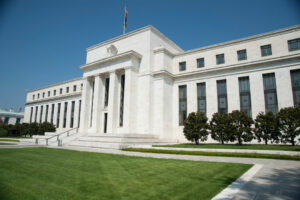WASHINGTON – Federal Reserve Chair Jerome Powell said on Wednesday recent high inflation readings had not changed the underlying “story” of slowly easing price pressures in the US as the central bank stayed on track for three interest rate cuts this year and affirmed that solid economic growth will continue.
The Fed also left interest rates unchanged and released new quarterly economic projections that showed officials now expect the economy to grow 2.1% this year, above what’s considered the US economy’s long-run potential and a substantial upgrade from the 1.4% growth seen as of December. At the same time, the unemployment rate is only expected to hit 4% by the end of 2024, barely changed from the current 3.9% level, while a key measure of inflation is projected to keep falling, though at a somewhat slower pace, to end the year at 2.6%.
In the context of declining interest rates, the projections showed the Fed still foresees a so-called “soft landing” from the post-pandemic spike of inflation to a 40-year high, though Powell said recent data had kept officials on a cautious footing to ensure price pressures do continue to ease.
Speaking after a policy meeting at which officials left the benchmark overnight interest rate in the 5.25%-5.50% range and held onto their outlook for three cuts in borrowing costs this year, Powell said the timing of those reductions still depends on officials becoming more secure that inflation will continue to decline towards the Fed’s 2% target even as the economy continues to outperform expectations.
Inflation reports at the beginning of the year showed price pressures remained “elevated,” in the Fed’s view, but “haven’t really changed the overall story, which is that of inflation moving down gradually on a sometimes bumpy road to 2%,” Powell said in a press conference.
But “I also don’t think that those readings added to anyone’s confidence” of a continued decline in inflation, Mr. Powell said, comments that put weight on upcoming inflation reports to confirm that price pressures continue to ease.
If they don’t, Mr. Powell said the Fed would maintain high interest rates as long as needed. Asked explicitly about recent comments to Congress that the Fed was “not far” from gaining the confidence it needs to cut rates, he sidestepped repeating those words and instead said his “main message” was that the US central bank still needed more data to change policy.
“It’s appropriate for us to be careful,” the Fed chief said, reiterating a go-slow approach to rate cuts that has been buttressed by the economy’s ongoing strength, with officials saying they are in no rush to ease monetary policy while the economy and the job market continue to grow.
BULLS AND DOVES
The outcome of the Fed’s two-day meeting will likely be welcomed by the Biden administration, with its outlook for continued growth and low unemployment alongside ongoing moderation in inflation and lower borrowing costs for consumers and businesses.
While officials affirmed their view for three rate cuts this year even as they upgraded the economic outlook, they trimmed the number of cuts expected next year from four to three for a slightly shallower pace of easing – a stance one analyst characterized as “bullish-dovish.”
Others saw a subtle endorsement of broader strength in the economy, including an improved outlook for productivity and the labor market, developments that can allow an economy to grow faster without generating pressure for higher prices.
The Fed “has stuck to its view that the underlying inflation picture is improving, notwithstanding the disappointing numbers in the past two months,” said Ian Shepherdson, chief economist at Pantheon Macroeconomics. The detailed projections show that members of the central bank’s policy-setting Federal Open Market Committee “have revised up their productivity growth or labor force forecasts … or both.”
U.S. stocks extended their gains following the release of the policy statement and updated projections and closed sharply higher. The U.S. dollar .DXY slipped against a basket of currencies, while yields on U.S. Treasuries fell. Investors strengthened bets of a first rate cut in June.
The updated economic projections showed the personal consumption expenditures price index excluding food and energy rising at a 2.6% rate by the end of the year, compared to 2.4% seen in the projections issued in December.
Nevertheless, 10 of the Fed’s 19 officials still see the policy rate falling by at least three-quarters of a percentage point by the end of this year, a median view first set in December and maintained despite recent stronger-than-expected inflation.
That represents a slightly hawkish change from the December projections, when 11 officials had seen three quarter-percentage-point cuts on tap for the year.
One key measure, the longer-run policy rate, was moved higher by a tenth of a percentage point, from 2.5% to 2.6%, reflecting the views of some Fed officials that the economy can support higher interest rates overall in the future.
The latest projections show the median policymaker expectation is for the Fed’s benchmark overnight interest rate to fall three-quarters of a percentage point in 2025, less than the 1 percentage point projected in December as part of a slightly slowed rate cut path, and by three-quarters of a point in 2026 as well, the same as anticipated previously.
“Economic activity has been expanding at a solid pace. Job gains have remained strong and the unemployment rate has remained low,” the Fed said in its unanimously approved statement.

